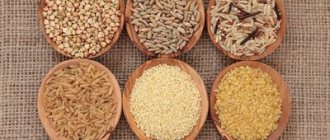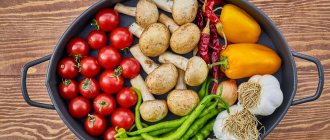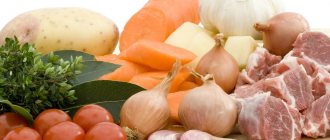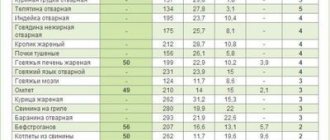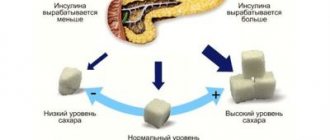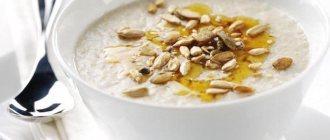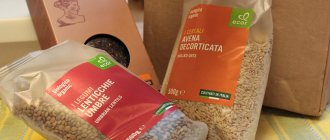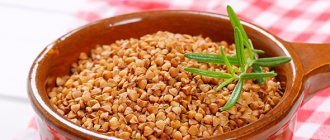People suffering from diabetes and following the rules of a low-carbohydrate diet are accustomed to daily counting the glycemic index and calorie content of foods. This is necessary for complete and safe nutrition.
Cereals should be an important component of any person's diet. The value of cereals lies in the presence of a large amount of fiber, amino acids, antioxidants and minerals in their composition. The glycemic index of cereals, their nutritional properties, safety for diabetics - all these indicators are discussed in the article.
What is the glycemic index
GI is an indicator of the effect of various foods on blood glucose levels. The higher the index of a particular product, the faster the processes of carbohydrate breakdown in the body, and accordingly, the moment of increasing the amount of sugar accelerates. The calculation is based on GI glucose indicators (100). The ratio of other products and substances to it determines the number of points in their index.
GI is considered low, and therefore safe for a patient with diabetes, if its indicators range from 0 to 39. From 40 to 69 is average, and above 70 is a high index. Decoding and recalculation are used not only by those suffering from diabetes, but also by those who are trying to lead a healthy lifestyle and follow the principles of a healthy diet. GI indicators, calorie content, ratio of proteins, fats and carbohydrates of main cereals are indicated in the table.
Glycemic index is an important safety indicator for diabetics
Properties of milk products
Dairy products play an important role in human nutrition. Health benefits associated with consuming dairy products:
- healthy digestion;
- increasing immunity;
- bone health;
- reducing the risk of developing caries;
- weight control;
- reducing the risk of developing most diseases.
Important. Consumption of milk, cottage cheese and yogurt is associated with a reduced risk of heart disease, stroke, hypertension, obesity and colorectal cancer - some of the leading causes of death in the world, as well as complications of diabetes.
Buckwheat
Cereals are quite popular among those who decide to eat healthy. There are even a number of specially designed diets based on porridge in combination with vegetables and lean meats.
An interesting point is that the GIs of raw and cooked cereals are in different categories:
- raw buckwheat – 55,
- boiled cereal – 40.
The composition and content of nutrients does not change, but the index values vary due to the presence of water in the boiled dish.
Water during the cooking process reduces the GI values of any cereal. This condition only applies if there are no other additives, not even oil.
The product belongs to the middle group. Adding milk or sugar already shows completely different results, transferring the cereal to the category of cereals with a high glycemic index. A quarter of 100 g of buckwheat consists of carbohydrates, which means you should refrain from eating it for dinner and combining it with other carbohydrate foods. It is better to combine with vegetables and add proteins in the form of fish and chicken.
Prevention of endocrine diseases
To prevent the development of diabetes, it is necessary to adhere to special prevention, the norms of which include:
- regular examinations in the hospital;
- proper nutrition;
- controlled use of medications;
- maintaining an active lifestyle;
- exclusion from the diet of alcohol, fatty, fried, salted and smoked foods.
Prevention is much simpler than full-fledged disease therapy
Mayonnaise is also undesirable in the diet if you need to prevent the development of any pathology.
Important! You need to visit the hospital for a routine medical examination. If your health worsens, you will need to undergo an examination unscheduled on a first-come, first-served basis or for a fee.
Rice
The performance of rice depends on its variety. White rice, a grain that has undergone the process of cleaning and polishing, has a score of 65, which puts it in the middle group of products. The brown variety of rice (not peeled, not polished) is characterized by an indicator of 20 units less, which makes it safer for diabetics.
Rice is a world-famous cereal that saturates the body with essential substances.
Rice is a storehouse of vitamins B, E, macro- and microelements, as well as essential amino acids. Patients need all this to prevent complications of diabetes (polyneuropathy, retinopathy, kidney pathology).
The brown variety is more beneficial both in terms of the amount of substances needed by the body and in terms of individual GI and calorie indicators. The only negative is its short shelf life.
Milk reduces the GI values of rice compared to water (70 and 80, respectively).
Cooking methods
Depending on the type of rice, the ratio of water and cereals, cooking times, and recommendations for use in preparing various dishes - pilaf, porridge, risotto, paella - change. Typically, the product packaging indicates the main parameters for its use.
But there are also general rules, which include the following.
- Pre-soaking in cold water reduces cooking time.
- It should be cooked in a thick-walled container over low heat.
- The cereal should be poured into boiling salted water.
- Frequent stirring is not necessary - the dish will lose its friability.
- After removing from heat, leave the rice covered for 10-15 minutes.
Spices and herbs help give a neutral flavor an unusual twist.
Pshenka
Millet porridge is considered a product with high index values. It can reach 70, which depends on the degree of density. The thicker the porridge, the higher its sugar content. However, individual beneficial properties make it no less popular:
- prevention of cardiovascular diseases;
- acceleration of the removal of toxic substances from the body;
- positive effect on digestive processes;
- reduction of cholesterol levels in the blood;
- acceleration of lipid metabolism, thereby reducing fat deposition;
- normalization of blood pressure;
- restoration of liver functions.
Flaxseed flour
The glycemic index of flaxseed meal has 35 units, which classifies it as a permissible product. The calorie content is also low - 270 kcal, which is important when using this type of flour for obesity.
Flaxseed is made from flax seed after its oil is extracted by cold pressing. The product has the following beneficial properties:
- normalizes metabolic processes;
- stimulates the functionality of the gastrointestinal tract;
- prevents pathologies of the heart and blood vessels;
- normalizes glycemia and cholesterol levels;
- binds toxic substances and removes them from the body;
- has an anti-cancer effect.
Wheat cereals
Wheat cereals have indicators ranging from 40 to 65 points. There are several varieties of wheat-based cereals that are popular among patients with diabetes and are famous for their valuable ingredients:
- Arnautka,
- bulgur,
- spelt,
- couscous.
Wheat porridge is considered a high-calorie product, but it has the properties to help reduce glucose levels, stimulate the gastrointestinal tract, and also activate regenerative processes on the mucous membranes.
Arnautka
This is a cereal made from ground spring wheat. Its composition is rich in vitamins, amino acids, and microelements, which help strengthen the immune system, restore the health of the heart and blood vessels, and improve the activity of the central nervous system. In addition, cereals have the properties of accelerating the regeneration processes of the skin and its derivatives, which is important for complications of diabetes.
Bulgur
A type of cereal obtained by steaming wheat grains. Next, they are dried in the sun, peeled and crushed. This processing gives the future dish a unique taste. Its index is 45.
Bulgur can also be used whole. These are brown grains with an outer shell. It is this porridge that has the greatest amount of nutrients and beneficial substances. Bulgur is rich:
- tocopherol;
- B vitamins;
- vitamin K;
- microelements;
- carotene;
- unsaturated fatty acids;
- ash substances;
- fiber.
Dishes based on bulgur - table decoration
Regular consumption of cereals restores the condition of the nervous system, regulates metabolic processes, and has a positive effect on intestinal function.
Spelled
It is a special type of wheat with a GI of 40, which differs in both shape and size from all known varieties. The spelled grain is quite large and is protected on the outside by a hard film that is not eaten. Thanks to this, the cereal is protected from all kinds of negative influences, including radioactive radiation.
Spelled grains are superior to wheat in terms of the value of their chemical composition. They help strengthen the body, normalize blood glucose levels, improve the functioning of the endocrine system, heart, blood vessels, and central nervous system.
Couscous
One of the types of wheat cereal with a GI of 65. Its composition is valuable with a large amount of copper, necessary for the normal functioning of the musculoskeletal system, the prevention of osteoporosis, as well as a significant amount of vitamin B5, which normalizes the functioning of the nervous system.
Corn porridge
This type of cereal is also a storehouse of vitamins, amino acids and minerals, but it must be handled with extreme caution, since the GI of the product can reach up to 70. It is advisable not to use milk and sugar when preparing corn porridge. It is enough to boil the cereal in water and add a small amount of fructose, stevia or maple syrup as a sweetener.
Corn grits are famous for their high content of the following substances:
- magnesium – in combination with B-series vitamins, improves cell sensitivity to insulin, has a beneficial effect on the functioning of the heart and blood vessels;
- iron – prevents the development of anemia, improves the process of saturating cells with oxygen;
- zinc – promotes normal functioning of the pancreas, strengthens immune processes;
- B vitamins – restore the functioning of the nervous system, their use is a preventive measure in the development of diabetes complications;
- beta-carotene – normalizes the functioning of the visual analyzer, prevents the appearance of retinopathy.
Corn grits should be used exclusively in boiled form. Corn flakes, popcorn or sticks have much higher GI values.
Products strictly prohibited for diabetes
If you have hyperglycemia due to diabetes, you should not eat certain foods. They are removed from the diet or eaten in minimal quantities with glucose calculations.
| Bread | Baking, biscuit, cake, pastries, loaf. |
| Milk products | Cream, including whipped cream |
| Soups | From fatty fish, lard, pork, with pasta, dumplings. |
| Fish | Caviar, canned food in oil, salted fish. |
| Meat, poultry | Pork, smoked meats, fatty goose, duck. |
| Vegetables | Potatoes, canned vegetables with garlic and pepper. |
| Cereals | Semolina. |
| Fruits, sweets | Chocolate products, bananas, raisins, grapes, candies. |
| Beverages | Semi-sweet wine, dessert wine, carbonated wine, lemonade, packaged nectars and juices. |
Of the fats, it is strictly forbidden to consume lard, both raw and as fried food.
Pearl barley
Barley porridge is a leader in the ranking of healthy and safe products. The index is 22-30 if it is cooked in water without adding oil. The porridge contains a large amount of protein and fiber, iron, calcium, and phosphorus. These elements should be present in the daily diet of both healthy and sick people.
Barley also contains substances that are involved in the processes of lowering blood glucose levels. It is used for preparing crumbly and viscous second courses, soups.
Pearl barley is the “queen” of cereals
Basic rules for creating a diet
To get a high-quality diet for several months, you must adhere to the following rules when preparing:
- include in your diet dishes that are steamed or without deep frying;
- avoid consumption of butter and flour;
- use only high-quality food with a low index;
- eat in small portions;
- eat at the same time.
The effects of the diet will only be noticeable if it is maintained over a long period of time. If, before starting to limit himself, a person carefully studies what the glycemic indicator is, then he will significantly increase his chances of successfully losing weight, treating an illness, or improving results in sports.
Barley grits
The product belongs to the group of substances with average index values. Raw cereal – 35, barley porridge – 50. Grains that have not been subjected to grinding and crushing retain the largest amount of vitamins and minerals, and the human body needs them daily. The cell contains:
- calcium;
- phosphorus;
- manganese;
- copper;
- iodine;
- unsaturated fatty acids;
- tocopherol;
- beta-carotene;
- B vitamins.
Thanks to its rich composition, cereal helps eliminate excess cholesterol, lowers blood sugar levels, strengthens the immune system, and normalizes the functioning of the central nervous system. Cereals contain a large amount of fiber, which ensures saturation of the body for a long time.
Amaranth flour
Amaranth is a herbaceous plant that has small flowers, native to Mexico. The seeds of this plant are edible and are successfully used in cooking. Amaranth flour is a good substitute for those crushed grains that have high GI values. Its EE index is only 25 units, calorie content is 357 kcal.
Properties of amaranth flour:
- has a large amount of calcium;
- has virtually no fat;
- contains substances that have an antitumor effect;
- Regular consumption of the product allows you to remove excess cholesterol and return blood pressure to normal;
- strengthens the body's defenses;
- allowed for those who cannot tolerate gluten (it is not included);
- considered a powerful antioxidant;
- Helps maintain hormonal balance.
Oatmeal and muesli
Oat porridge is considered an indispensable product on the table. Its GI is in the average range, which makes oatmeal not only healthy, but also safe:
- raw flakes – 40;
- on the water – 40;
- with milk – 60;
- with milk and a spoonful of sugar – 65.
Oatmeal is a dish allowed for the daily diet of both sick and healthy people.
You should not give preference to instant porridge, just like muesli (GI is 80). Because, in addition to flakes, the composition may include sugar, seeds, and dried fruits. There is also a glazed product that you should avoid.
Expert advice
Cereals contain more than 70% carbohydrates, which tend to break down into glucose. The faster the breakdown process occurs, the higher the blood sugar level rises. There are ways to lower the GI of the prepared product so that the breakdown process slows down, and also make it safe for diabetics:
- adding a spoon of vegetable fat;
- use coarse grains or those that cannot be ground;
- do not use products with an index above average in the daily diet;
- use a double boiler for cooking;
- refuse added sugar, use substitutes and natural sweeteners;
- Combine porridge with proteins and a small amount of fat.
Following the advice of experts will allow you to eat not only healthy foods, receiving all the necessary substances, but also make this process safe for health.
Do diabetics need cottage cheese in their diet?
A diet high in calcium can help keep bones strong. One way to do this is to consume cottage cheese.
Since obesity develops against the background of diabetes, it is cottage cheese that helps reduce body weight due to the presence of vitamins such as A, B, C and D in its composition.
Many diabetics try to eat low-fat cottage cheese. However, experts agree that a low-fat product is not healthy.
Low-fat cottage cheese is famous for having less fat, but during its production, vitamins, zinc, phosphorus and other useful microelements are removed from the product along with fat, and this negatively affects the absorption of calcium by the body.
In addition, many manufacturers, in order to improve the taste of the low-fat product, add sugar, sour cream and flavor enhancers. That is why give preference to 1.5% cottage cheese. Use the product in its pure form without adding sour cream or sugar in an amount of 100–150 grams per day.
